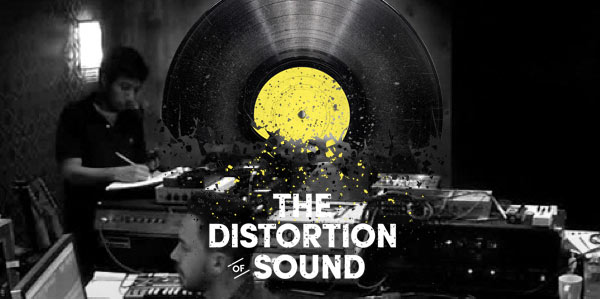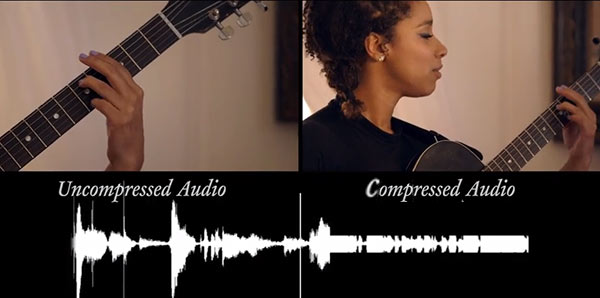“The Distortion of Sound”…Distorted!
I received an email from one of my former students this morning. His name is Rob Marshall and he was an exceptionally talented and motivated audio student while studying at CSU Dominguez Hills, although he had already had considerable experience and was somewhat older than the rest of the students. He wrote to tell me about a documentary that he recently worked on entitled “The Distortion of Sound”. It’s a documentary on the state of the music industry, the downward spiral in fidelity caused by highly compressed music (MP3), and the fact that artists and producers are unhappy about the sound of their productions as played in portable devices and ear buds.
The film features a bunch of very high profile artists, audio professionals and music producers including Quincy Jones, Slash, Snoop Dog, Hans Zimmer, Mike Shinoda, Lianne La Havas, Kate Nash, A. R. Rahman Dan the Automator, Manny Marroquin, Andrew Sheps, Neil Strauss, Dr. Sean Olive, Greg Timbers and Chris Ludwig. The film lasts about 22 minutes. It was sponsored by Harman and will become part of the Grammy Museum in downtown Los Angeles. You can watch the film at on YouTube or at the film’s website (Click here).
It’s definitely worth watching. The focus is on celebrities lamenting the loss of emotion and soul in reproduced music AND the blame is clearly put on the data compression techniques that reduce the file size of a music file by as much as 90%. Algorithms like MP3 and AAC remove parts of the overall sound that won’t be missed by the average consumer…and no technology yet devised can get those components back.
The second part presents a brief “history of recorded music” and takes us along a timeline starting the 60s with vinyl LPs, to 8-tracks in the 70s, to cassettes in the 80s and finally CD in the 90s. Then the MP3 arrived in the 2000s, portability became important and music quality suffered. The communication and emotional link between the artist and consumer was severed when the music business switched from physical media to low fidelity highly compressed files.
I was somewhat dismayed when they attempted to make the point about “compression” and changed the focus from data compression technologies (MP3 etc) to amplitude compression. As singer/songwriter Lianne La Havas sings one of her songs, the lower third of the screen has a moving graphic showing the uncompressed waveform of the associated audio. After a few moments, the compressor is turned on, the waveform goes almost completely flat and the perceived volume is suddenly lowered. The second example does the same thing again only this time the music is rock and roll with crashing drums and loud guitars. The “compressed” example is crushed, hugely distorted and almost unrecognizable as the original uncompressed version.
Figure 1 – Screen grab from the film “Distortion of Sound” showing amplitude compression being applied to tune.
They lost me right there. It was not an accurate portrayal of what happens during the recording production process. The Lianne La Havas tune was lovely in the uncompressed format but would never be released like that. The normal mastering process would have brought the peaks down and brought the overall volume up. As for the rock tune, they went so far off the mark; it takes away from their message. Too bad. The opportunity was there and they bent the truth to make the “distortion” clearly obvious. It might have been better to play a low bit rate MP3 vs. a CD spec version. Think back to the “Mosaic” articles that I wrote recently.
I should download an album by any of the artists represented in the film and evaluate the dynamic range of their creations. I wouldn’t be surprised to find the usual highly mastered, flat tunes that they say they don’t want.
Kate Nash delivers the question that we’re left with at the end of the film. She says, “I don’t want my name associated with low quality things. If I were in control, I would want it to be the highest quality possible. I don’t understand why it isn’t, really. Why isn’t it? Who’s got the answer to that?”
The film asks the question but doesn’t provide the answer to that question or any of the other ones posed in the 22-minute film. There are answers…and it’s squarely on the artists, producers, engineers and labels to “bring sound quality back”. This is not a problem of MP3 compressed files anymore…it’s the standards that the labels demand that is destroying fidelity.



Cannot believe this article was not sponsored by Pono ..
BTW, I’m not referring to your article Mark – rather the video ..
I agree they misrepresented how dynamic compression shows up in the real world.
On the other hand I believe that, above 16/44, dynamic compression is a much larger problem than data compression. When is the industry going to address dynamic compression?
I really liked the article. Apart from the compression comparison snafu the artists are all shown to be coming from the same viewpoint, music is something you FEEL, a good recording captures that emotion, and the artist doesn’t want that art to be corrupted.
The biggest irony here is that this documentary was delivered via YouTube. However, the bitrate on both the video and audio (AAC) was such that the 1080 video looked very good, and the audio was also very good, so good in fact I have now discovered a new artist: Lianne La Havas; toward the end of the documentary she’s shown singing with her guitar at a small venue (my favourite type) and is totally connected with the audience (even though I wasn’t there she connected with me).
BTW I watched this documentary on my Note 3 connected via USB to a Fiio X3 connected to a Ray Samuels “Black Bird” through Sennheiser HD 25 1 IIs – a bit OTT but for me the ultimate portable hi-fi.
Thanks for pointing us to the film, but Linkin Park, Snoop Dog, Slash et al complaining about (lack of) dynamic range. Huh?
I’m with you.
OK. I watched all 22:07 of the video and I am sorry to conclude that it completely missed the mark and will further confound, confuse and disappoint all. What it failed to point out is that the mastering of the master files is what sucks the life out of the music. Compression is the root cause but it’s not data compression as you have pointed out and have proven, Mark. It’s a Tower of Babel. Could Mr. Marshall be so uniformed or careless? Is there an agenda? Sad, sad, sad…
It’s not Rob Marshall’s fault…he was one of the sound designers and was told what would go in and what would be left out. When I asked him about the inconsistencies be told me that they wanted it that way.
If this conflation of data and amplitude compression was deliberate as you state (and I believe you), that is unfortunately consistent with the emerging major label story that the only way (maybe) to get music not ruined by loudness war crap is to pay much, much more for “high res” music, using a blizzard of disingenuous, scientifically fraudulent descriptions of “stair step” sampling curves, file sizes equated to quality, and “analog-like” as the ultimate sound. As stated elsewhere, one could view this as an extortion-based marketing plan – “pay us more so that we don’t put in the extra effort to dynamically compress the heck out of your music”.
You’re in a fight with very well financed, very intelligent, very amoral MBAs who know full well the actual science and story, but have developed a story solely developed to maximize revenue – accuracy, honesty and quality be darned.
I am one such MBA, albeit operating in industries completely unrelated to music (and I’d like to think without the amoral aspect), so I know the type very, very well behind the creation of this crap.
It’s truly unfortunate that the marketing departments can’t be transparent and honest about selling or re-selling their music catalogs.
I just noticed that Harman International Industries was associated with this film – it’s the only corporate logo on the main web page. Ouch! This seems to go against a great deal of what I thought Dr. Sean Olive stood for. You’ve probably already thought of it already, but it would be interesting to see what Sean will say about this on the record.
I sent an email to Sean and haven’t yet heard back. He’s a very busy guy but I’m sure I’ll hear from him.
Thanks for sharing the video “Distorsion of Sound”
So incredibly true !
Unfortunately as stated in the video people most people just don’t care !
Audiophiles seem to have become a rarer breed…and we are getting older.
I love the music and always will.
A fan of yours Mark.
Thanks Marcel…we may be getting older but I find that younger people including my own children love listening to music and do appreciate fidelity. Maybe it’s just the influence of Dad, but I think if we sneak better fidelity in their lives it will make a difference.
Video is really misleading. Dynamic compression in the studio is a much bigger issue to the quality of sound as we cannot fix that. We can always go buy a higher quality recording even vinyl and remove data compression issue. The data compression rate used was really low. Only one speaker actually mentioned the difference between hi and low resolution MP3. I went to the linked website of one of the sponsors of the video who offer a product to improve quality of compressed sound. The demo they offered made the sound worse. Sound became brighter and excited but no more detail. It looks like a marketing campaign to create confusion is beginning. I must confess I was not an MP3 fan as I love listening to high end audio. I also love music and if we misrepresent MP3 standard then whatever stuff is pushed to replace it will just make things worse.
I believe the demand for fidelity must come from the artists. They say they want emotion, fidelity, etc, but I honestly believe they are not technically sophisticated enough to know exactly what that means. Can’t an artist stipulate in their contract that they will only record at, say, 96/24 or better? Of course, that would not guarantee a perfect product due to intermediate handling but at least the original could be re-processed by others to achieve the artist’s intentions.
Find an artist who understands.
You absolutely right. It has to start with the artists…but they rarely have the technical knowledge or influence to change the way things are. The record companies, producers and managers KNOW what’s best.